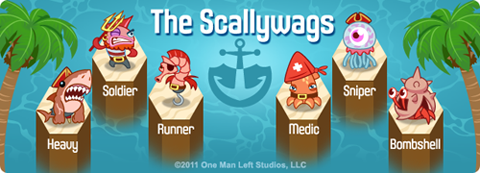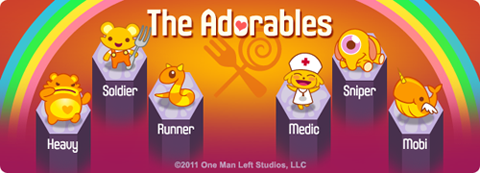We’re still balancing Outwitters gameplay. When thinking about changing, removing, or adding gameplay I try to keep two aspects in mind, choices and unpredictability. I’ll speak to the choices aspect today, as I’m still trying to grapple with that whole unpredictability thing in a turn-based perfect-knowledge setting. When we set out to create Outwitters, we wanted to make a simplified strategy game. One where players can easily pick it up much in the same way they pick up an iOS arcade game. The reality of the situation is this has become extremely difficult to achieve. I have a strong hunch it’s harder to do in our game due to the context in which our players are using strategy. It is essentially a “war” game. Players do battle with each other over vivid, colorful venues with fun-looking characters. The overall goal is simple: Destroy the opponent’s base. But the way in which you achieve this goal can be complex. If we make the choices too few and too simple (ie, with the arcade game mentality) the game itself becomes uninteresting very quickly even with a human component on the other side. Just about every “enhancement” to the gameplay we think of adds complexity to the game rules or mechanics. It adds “potential” fun to the initiated, but raises the barrier to the uninitiated. I feel there could be a strategy game idea out there that isn’t centered around battles/violence that could exhibit arcade-style ease-of-play but still have an interesting depth to it.

The Scrambler overtakes enemy units and makes them change to your team
An example of making player choices too simplified can be found in an earlier build of Outwitters. In Outwitters each player has a team of characters to choose from. Each team shares 5 of the same units (just different looks), but 1 unique unit to that particular team. Each turn a player has the choice to move, attack, or add a new unit to the game board based on points the player can spend per turn. In an effort to simplify the game, we made the cost of adding a unit to the board the same for each unit. Every unit cost the same, even the unique ones. We thought removing the barrier to learn how much each unit costs helped make the game rules easier to digest, and also focused more on what units you chose to spawn (strategy) rather than trying to manage your points. We found a couple of issues with this approach.
Firstly, this limited the effectiveness of any particular unit. We couldn’t make any unit be greatly powered in one particular aspect, especially the unique units, because they would instantly become the dominant strategy. Since every unit “cost” the same to acquire, the units had to be somewhat similar in damage and range capabilities. Secondly, because no unit had no obvious advantage over another, newer players floundered in picking the “correct” unit to add to the game board for a particular strategic situation. When players became experienced with the game, they understood the nuances of each unit and started using them more effectively to gain that little edge they needed to get the jump on another experienced player. The problem with this? You had to become “experienced” to have a decent understanding of the unit choices.

Bombshell is able to do splash damage to several tiles at once
So we decided to change a couple of things. Our original idea for Outwitters was for players to choose their favorite teams not just on aesthetic choices, but strategic ones as well. The current state of the game was heavily in the ‘aesthetic’ camp for team choices. We made the unique unit for each team cost twice as much, and also made them much more powerful. This had a positive effect in that it made unit choices much clearer and focused for newer players. This extended even beyond the unit choice screen and into the overall playing strategy of the game. Before this change, I’d see new players just do random moves because they really can’t see how their actions would effect the game beyond a couple of moves. Introducing, for simplicity’s sake, a “hero” unit, players began to focus their strategies around that unit’s strength. It’s what we wanted to begin with! Players clung to their hero units because:
- It cost a lot. The loss of a “hero” unit was painful.
- That hero unit’s actions clearly implied how it’d effect the game. If a hero unit could do 2-3 times as much damage, or transport waves of units across an entire map, or take over enemy armies *easily*, the player can easily make the connection and think, “hey, this is an easy way to attack the enemy’s base and win”. Before this change I felt like the answer to attack an opponent’s base was far less clear for inexperienced players.

Mobi can “launch” units towards the enemy base by sucking them in and spitting them out